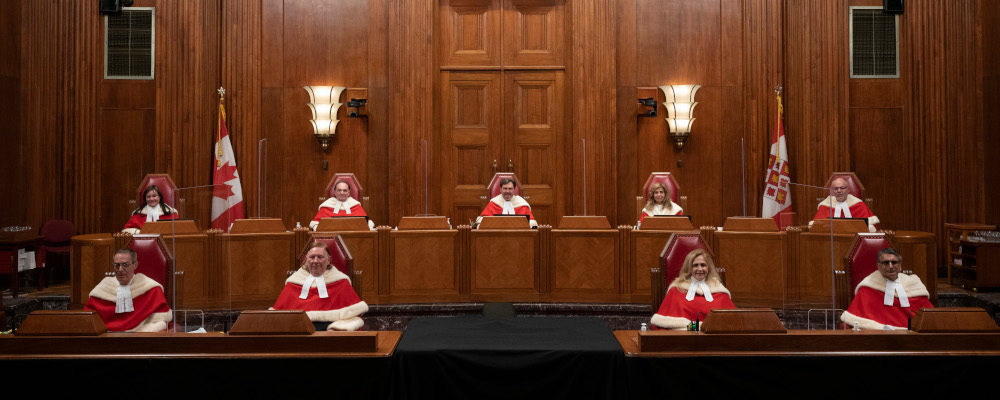On Saturday, Sean Fine of The Globe and Mail published a very interesting article positing that a “liberal” consensus on the Supreme Court that has existed for the past four decades has “fractured” in recent years. The well-researched piece brings public consciousness and data to a real trend. There has been markedly less unanimity on the Supreme Court in recent years.
Justices Suzanne Côté, Russell Brown, and Malcolm Rowe have agreed with each other frequently in deciding cases in the same way. Justice Michael Moldaver and, less frequently, Chief Justice Richard Wagner, have often joined them, arriving at majority opinions. But these two judges in the purported “centre” of the Court have also sided with the other four judges—Justices Rosalie Abella (now retired), Andromache Karakatsanis, Sheilah Martin, and Nicholas Kasirer—in just as many if not more high-profile decisions. And in the most important Supreme Court case in recent years, Vavilov v Canada, judges from all three of these “camps” came together to produce a majority opinion of seven judges, explaining how courts are to review actions of the administrative state. So while there is a real phenomenon here, its magnitude is debatable.
More importantly, linking such trends to partisan considerations or a left-right political spectrum (including the fact that Stephen Harper appointed Justices Côté and Brown) is extraordinarily simplistic. “Conservative” judging can take many forms, some of which are advocated by political progressives and partisan Liberals.
As Alyssa Tomkins has noted, Justice Rowe was appointed to the Supreme Court while Jody Wilson-Raybould was Justice Minister. A year later, Wilson-Raybould allegedly sought to appoint Manitoba judge Glenn Joyal to the Court. The PMO was allegedly alarmed with this choice, viewing Chief Justice Joyal as too “conservative”. This saga, which should have remained confidential, was leaked to the media in the aftermath of the SNC-Lavalin scandal, at which point Chief Justice Joyal was forced to reveal that he removed his name from consideration due to his wife’s illness.
What can we learn from this? Wilson-Raybould is no conservative, from either policy or partisan perspectives. But the similarities between Chief Justice Joyal and Justice Rowe are clear. The judicial “conservatism” that can arguably be attributed to these two judges can just as easily be described as “judicial humility”. This judicial humility could fairly be described as dispositionally “conservative” but is not necessarily politically “conservative”. This “conservatism” has very imperfect overlap with, and can frequently be an obstacle to, achieving conservative political ends.
Chief Justice Joyal’s decisions and extrajudicial commentary (like Justice Rowe’s) indicate deep skepticism of judges overturning elected officials’ decisions. But this exists irrespective of a decision’s contents: his high-profile dismissals of challenges to Manitoba COVID restrictions are clear examples of choosing to uphold elected officials’ decisions over the submissions of right-wing advocacy groups. This is similar to Justice Rowe: one of the most interesting aspects of Fine’s analysis was observing that Justice Rowe, even more than Justices Côté or Brown, has been least likely to find rights violations. For example, in Trinity Western University’s unsuccessful saga to have a proposed law school accredited, he alone did not find religious freedom rights to be limited. Justices Côté and Brown, on the other hand, found the Charter to be unjustifiably violated while the other six judges found religious freedom rights to be limited, albeit reasonably so.
Another characteristic of Justice Rowe, noted by Fine, is being “not remotely tough on crime”. This is also shared with Chief Justice Joyal. Given the extent to which modern political conservatism has sought to be “tough on crime”, the views of these judges cast further doubt on what is a “conservative” judge. In other words, there is clearly a tension between judicial humility, which would be disinclined to convict a person of a crime and subject them to the carceral state unless clearly warranted, and political conservatism with respect to the criminal law. In this vein, Fine also noted that Chief Justice Wagner and Justice Moldaver have in many ways been the two most “tough on crime” Supreme Court judges despite the fact that they have probably been the two most “centrist” judges in high profile constitutional cases. This too casts doubt on a left-right conceptualization of the Canadian judiciary.
There is nothing inherently politically conservative about a restrained view of judging. Indeed, its advocates include prominent progressive academics such as Jeremy Waldron and Mark Tushnet. They have argued that a circumscribed judicial role is less susceptible to long-term partisan meddling.
This does, of course, put the primary duty of rights conceptualization onto legislatures. As Howard Anglin has noted here before, the proposition that courts are essential to safeguard rights has been treated as self-evident in many circles, particularly in much of Canada’s Laurentian elite, for the past forty years. But work comparing jurisdictions with and without strong judicial powers, including that done by Professors Waldron and Tushnet, casts doubt on this. There are myriad examples where legislatures have been just as good if not better than courts in protecting minority rights. There are exceptions, to be sure: Waldron has conceded criminal procedure may be such an exception. But in the main, legislatures are not inherently less likely to arrive at long-term sustainable compromises in conceptualizing rights: conceptualizations that are almost always subject to reasonable disagreement.
This does force legislatures to actually turn their attention to questions they would rather avoid. Canadian examples include matters as varied as assisted dying and private medical care. But as Professor Waldron has noted, while it may be politically inconvenient for legislatures to address these matters, it is vastly preferable from a procedural perspective to have these issues decided before legislatures rather than courts. Courts, unlike legislatures, have relatively narrow skills and evidence before them in making decisions. Given this, their decisions can constantly be sought to be distinguished, narrowed, and/or overturned.
Nor is having such a modest judicial role unusual. As I have written here before, “The United Kingdom, Australia, and New Zealand […] have courts with far fewer powers, are hardly rights-abusing dystopias compared to North America, and have not suffered the same negative consequences of judicialization.”
‘Conservative’ judging can take many forms
On the note of our North American neighbour, many American progressives have advocated for more such “judicial restraint” in recent years. Though the Supreme Court of the United States advanced many progressive social causes between the mid-1950s and mid-1970s, that has reversed. The federal courts in the United States are now, very much like they were in the early 20th century, known for being far more willing to strike down progressive legislation and regulations than conservative legislation and regulations. This has made the worldview of a judge like Chief Justice John Roberts of the United States Supreme Court, genuinely advocating for a minimal judicial role, much more attractive when contrasted to many of his colleagues who are more likely to strike down progressive legislation and regulations.
Now let’s return to Jody Wilson-Raybould. Is it possible that she, a clear political progressive but very much not of Laurentia, shares a view of the judicial role more similar to Justice Rowe, Chief Justice Joyal, or Professor Waldron? I have no personal insight. But it is more than conceivable that, in light of her experience, she believes that strong judicial power, whatever its short-term benefits, poses long-term difficulties in creating sustainable progressive change.
Lest there be any confusion, there may be those who argue for “judicial restraint” only when it suits their preferred causes. But that this argument is occasionally made in bad faith is not a response to it being made in good faith.
There are also clearly other conceptualizations of “conservative” judging. Many of them are prominent in American (and to a lesser extent Canadian) law right now, such as the originalism practised by Justice Clarence Thomas of the United States Supreme Court or the “common good constitutionalism” that Harvard Law School’s Adrian Vermeule has advocated. These may well be inimical to many political progressives.
Nor should one assume that a restrained view of the judicial role is necessarily appropriate. As Benjamin Berger has observed, though the constitution’s meaning can be disputed, too humble a view of the judicial role can lead to abrogating judicial responsibility: responsibility that includes applying the constitution.
At the end of the day, however, nothing should lead inexorably to the view that because a politician or judge views expanded judicial power with skepticism, that is incompatible with political progressivism. Because as I have noted here before, while the Charter has mostly (though by no means entirely) been used to advance progressive causes over the past forty years, there is no guarantee that will continue in perpetuity. Advocating for judicial humility and an expanded role for legislative action may very well be more sustainable than seeking to have judicial decisions consistently furthering progressive or conservative causes.




